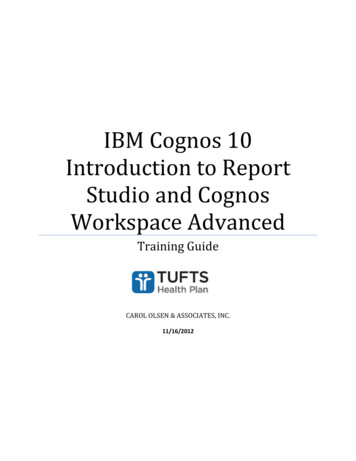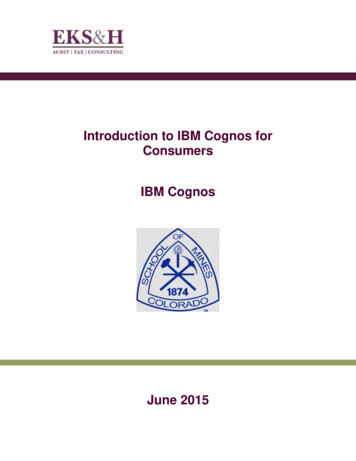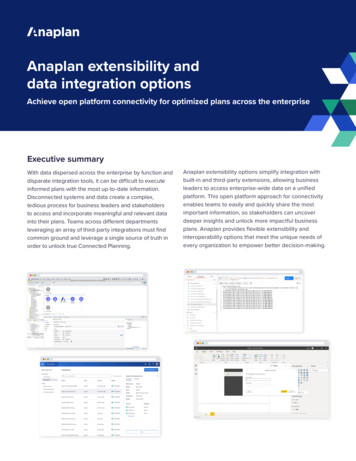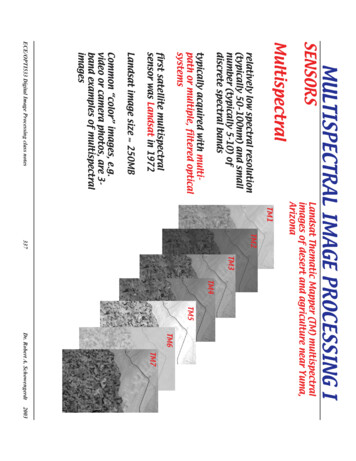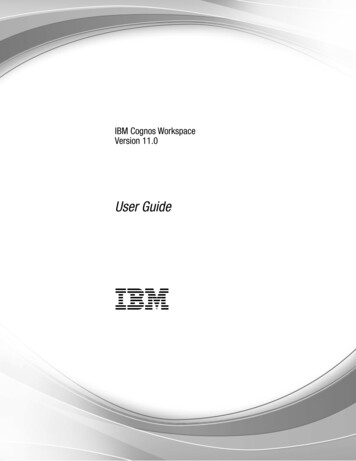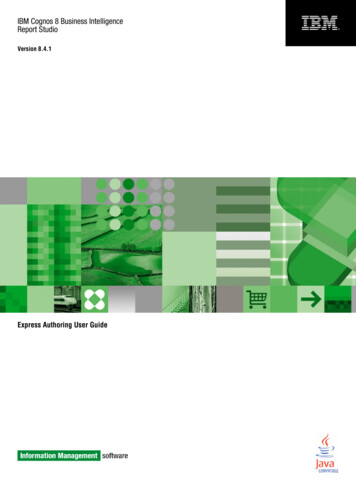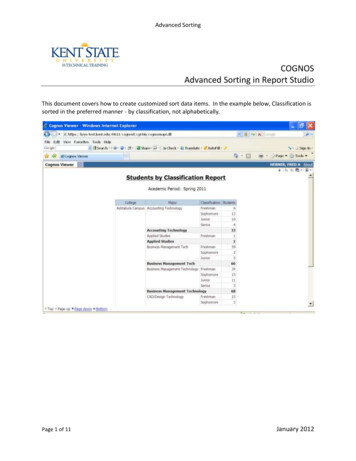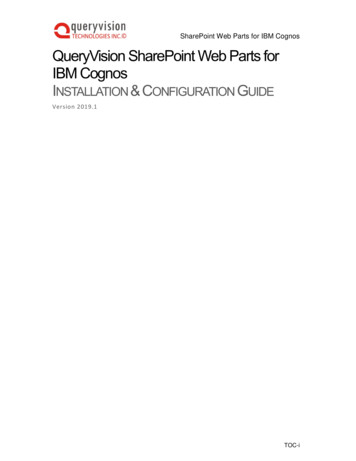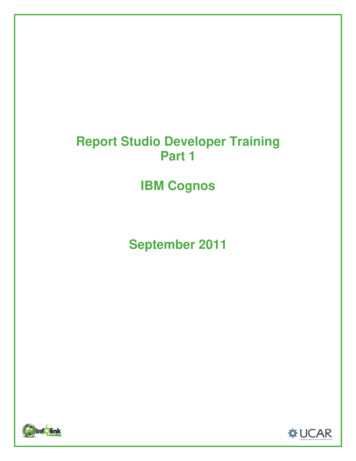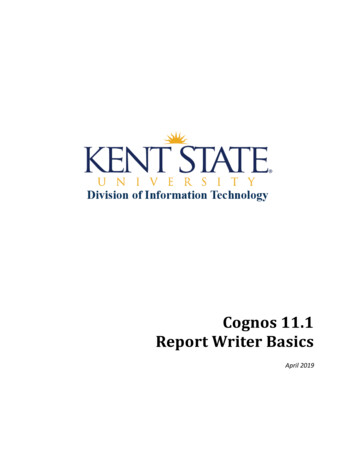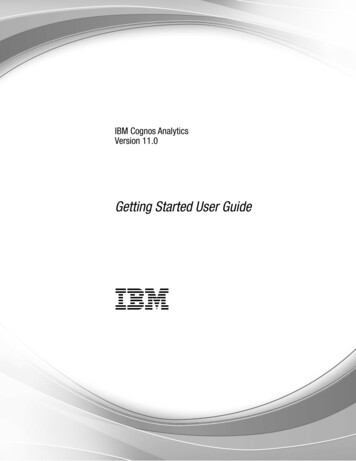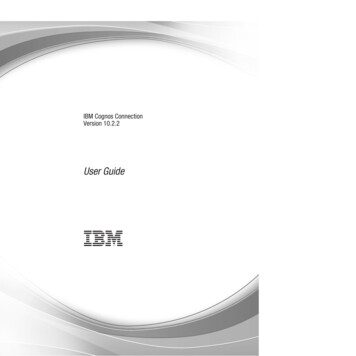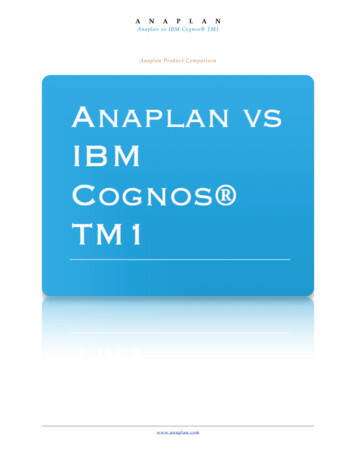
Transcription
ANAPLANAnaplan vs IBM Cognos TM1A n a p l a n P ro d u c t C o m p a r i s o nw w w. a n a p l a n . c o m
Table of ContentsIntroduction!3Technology!5Time to Value!8Adaptability!14Cost of Ownership!15Summary!16About the Author!17Nomenclature!18Technical Products Reference!19A n a p l a n!Product Comparison2
IntroductionTraditional on-premise enterprise vendors struggle to solve the challenges of theBusiness Analysts today who need to perform dynamic planning and analysis in avolatile business environment. On-premise solutions are expensive, requiring costlyconsultants and heavy IT involvement with huge maintenance and support bills. Thesolutions are rigid resulting in weeks and months to make simple changes, with long ITqueues, out of synch data, and constant rework. Users are constantly frustrated withdisjointed, manual, and static tools that require downtime for updates and upgrades.In parallel two additional phenomena are occurring. IT is oversubscribed: IT is struggling to keep pace with the growing demands of thebusiness and today’s existing IT queues are strangling IT productivity and credibility. Enterprise users want easy to use, instant access, collaborative tools for the “frontlines”. Business users consume personal products with modern and clean userinterfaces that provide a self service experience like Facebook , Dropbox , Skype ,etc. They expect the same type of user experience from their enterprise software.Enter Anaplan, the next generation of business performance management in the cloud.Anaplan is the self-service platform that connects your front lines across a broad set ofuse cases, liberating IT, and saving the organization both time and money.It is the revolutionary new platform which democratizes design and processdevelopment that was previously constrained by an army of consultants and complextools. Business Analysts manning the front lines of the enterprise are now empoweredby Anaplan to design, build, and deploy business applications. The result, performanceA n a p l a n!Product Comparison3
improvements and top line productivity gains without putting more demands onstressed and undermanned IT organizations.Anaplan is built using the latest innovative technology and is a disruptor to theoutdated, on-premise architecture of IBM Cognos TM1. Organizations that arelooking to IBM Cognos TM1 to build enterprise scale applications, running complexcalculations in driver based models with thousands of contributors, will find all of thosecapabilities in Anaplan - only now models can be built by Business Analysts, businesslogic and metadata changes can be done in real-time, and models can be built in days,not months. In addition, Anaplan will contain increased mobile, predictive, and socialcapabilities making it the leading comprehensive platform to support the needs of themodern enterprise user.Anaplan Key AdvantagesA n a p l a n!Product Comparison4
TechnologyAnaplan is Built Using Innovative, Web 2.0TechnologyAnaplan was built from the ground up to be a cloud based platform. Further, whatdifferentiates Anaplan from other products are the patent pending innovations thatallow Annaplanners to build enterprise scale, instantly adaptable, high performingapplications with a modern user experience.Anaplan’s cloud based architecture yields many distinct advantages, especially whencompared to the on-premise architecture of IBM Cognos TM1. The cloud shifts themanagement of infrastructure away from scarce organizational IT resources andBusiness Analysts can build applications without having to go through the IT queue.Anaplan takes IBM Cognos TM1 head on in terms of enterprise scale, performance,and calculation speeds across massive data and user volumes but with added flexibilityand a modern user experience via the following innovations:Business Analysts can change their models ON THE FLY The in-memory database system stores its data in main-memorywithout trafficking through a database, enabling faster processing speedsover larger, more complex data sets. You can make changes (add/deletedimensions, rename objects, change calcs, etc) and they are instantlyupdated throughout the model.A n a p l a n!Product Comparison5
Inputs into large, complex models are INSTANT When a user changes input data in Anaplan it is submitted using apatent pending HyperBlock technology. This technology uses highlyselective logic to pinpoint specific data elements to be changed and thenonly traffics the minimal data packet in a single round trip back to theserver. Recalculation time is typically under a second.Anaplan users have a MODERN, CLEAN USER EXPERIENCE Anaplan is built on a scalable, open architecture using a Java 2Platform, HTML, Javascript, and 64 Bit. Anaplan will support the newHTML 5 and will be fully functional on a broad range of mobile devices.Anaplan’s application builder allows for RAPID DEVELOPMENT Anaplan uses multi-stage execution to create a modeling environmentthat supports parallel computation. This innovation enables rapid, “toolof thought” application development.A n a p l a n!Product Comparison6
Contrary to Anaplan’s innovative, cloud based technology, IBM Cognos TM1 reliesupon on-premise architecture dating back to the 1980‘s. Founded in 1983 and acquiredby IBM in 2008, the underlying technology has remained the same; on-premisearchitecture with in-memory calculation engine for aggregating data.The ability to aggregate data in-memory with IBM Cognos TM1 is a key benefit whencompared to other on-premise products like Oracle Hyperion Essbase, but not whencompared to a cloud based planning platform like Anaplan. On-premise still meansthat model updates, metadata updates, and product updates need to be coordinatedacross IT resources and result in end user outages. Overall, Anaplan’s cloud is morecost-effective, less disruptive to the business, and easier to manage from aninfrastructure and product update perspective.A n a p l a n!Product Comparison7
Time to ValueImplementations in Days and WeeksBusiness Self ServiceEasy to Adopt“Single Platform vs Stack of Products”The simplicity of Anaplan’s single platform removes the complexity that is required todevelop and maintain solutions in the on-premise world. In Anaplan, there is oneplatform for both development and end user consumption, no infrastructure to support,and all model and data changes are instant. It is the single place to build your planningmodels, interactive dashboards, and manage your enterprise metadata. The impact tothe business is that a collaborative team can now change assumptions, add scenarios,and create multiple sandbox versions on the fly in Anaplan without scaling limitationsor change latency. The platform is easy to use and allows the business user to design,build, and deploy applications in days and weeks, not months.Contrast Anaplan’s single platform with the IBM Cognos world; there are moreproducts to support, multiple levels of infrastructure to install and manage, and changeis not instantly reflected but must be coordinated across people (IT consultants),software products, and infrastructure. Tiered infrastructure and multiple products addto the complexity in managing and staffing IBM Cognos TM1 implementations.A n a p l a n!Product Comparison8
First of all, IBM Cognos TM1 infrastructure requires that IT technicians have expertisein tuning and managing a multi-tier, on-premise environment such as the illustrationbelow. Additional enterprise infrastructure will include Development, UAT,Production, and Disaster Recovery servers.Secondly, from a tooling perspective, IBM Cognos is represented by many products: IBM Cognos TM1 Architect: stand aloneclient and design interface for creatingmulti-dimensional cubes Turbo Integrator: used to extract, transform,and load data into the cubes. IBM Cognos TM1 Contributor: planningweb interface IBM Cognos TM1 Web: alternative webinterface IBM Cognos Framework Manager: datamodeler needed to integrate with IBMCognos BI IBM Cognos BI: report authoringA n a p l a n!Product Comparison9
The impact to the business is that IBM Cognos TM1 projects are much more complex,require many more resources, and take significantly longer to implement than a similarproject in Anaplan.“Enables Business Self Service”In Anaplan business applications are rapidly built by Business Analysts using a naturalbusiness language without having to be concerned about the underlying infrastructure.IBM Cognos solutions are developed by consultants across a range of products (ie IBMCognos TM1, IBM Cognos BI, etc) with each product requiring unique IT skill-setsand IT infrastructure support teams.Anaplan is geared to the Business Analyst with power spreadsheet skills along with thedeep domain knowledge to build and deploy business applications.Business Self Service with Anaplan: Familiar Business Language: Excel-like formulas for powerful multi-dimensionalmodeling Quick Skills Ramp: 2-3 day ramp for a Business Analyst with Excel spreadsheetskillsA n a p l a n!Product Comparison10
Clean, Simple User Experience: similar to today’s consumer software (Twitter ,Facebook , Dropbox , Google Apps , etc.) Anaplan presents the user with asimple interface while hiding the complexity below the surface. Real-Time Modeling: Business Analysts can easily make changes to assumptions,business logic, and add scenarios on the fly to manage today’s rapidly changingbusiness environment. " Sophisticated Data Load Interface: Business Analysts can easily import datausing the elegantly designed Anaplan data loader. Anaplan’s data loader is moreintuitive than the script based Turbo Integrator of IBM Cognos TM1In contrast, IBM Cognos TM1 is more focused on enterprise IT and uses a proprietarysyntax and scripting language. It is harder to build TM1 applications because it’s not anatural transition from a spreadsheet environment and it requires dedicated applicationspecific skills. Building products across planning and analytics for IBM Cognos requires the Configuration Army:The Configuration Army The TM1 skill-set is typically an IT or consulting resource withexperience building cubes/dimensions/applications/etc in IBMCognos TM1 Architect’s scripting language called Turbo Integrator.Log files are used for application configuration and the services canbe stopped and started through the Windows services. The webinterface is then configured using a separate tool called IBMCognos TM1 Contributor Consulting and IT resources are needed to integrate data betweenIBM Cognos TM1 and IBM Cognos BI using IBM Cognos Framework Manager Consulting and IT resources are needed to author reports in CognosBI. Data modeling and report authoring skills are needed.A n a p l a n!Product Comparison11
Consulting and IT resources are needed to manage infrastructure,install/configure software, support application developers, facilitatepatches and upgrades, and run backups/restores/disasterrecoveries.The time to value difference also exists in the proof of concept process. The AnaplanChallenge is a 2-3 day process where the pre-sales team will prototype a customer’smost complex spreadsheet model, free of charge. The process takes days with littledisruption to the business. On the other hand, the IBM Cognos TM1 process requiresmore time, commitment, and investigative costs from the customer.“Easier to Adopt”The Anaplan adoption strategy is to quickly up-skill the Business Analyst with a shorttraining period, and then follow with a best in class customer service and technicalsupport. Each Anaplanner has immediate access to a support structure and designteam as they transition from existing applications to the new cloud based designs.A n a p l a n!Product Comparison12
The Anaplan Adoption Strategy""""Always Connected: Anaplan Guru Station - customers can book 1 hour modeldesign review appointments with any guru Live Chat to immediately engage with an Anaplan guru Skype Access - immediate support through Skype Telephone Assistance - Anaplan support via telephone""Rich Online Support Resources: Anapedia comprehensive online help is available 24 x 7 x365 On-demand video training for more advanced topics andself-paced courses is provided via the Anaplan Universitysite Sample Model Library for partners and customers""Community Edited Support Content: “Go to the crowd”: Anaplanners can search by topic, posttopics and see answers to platform design andimplementation questions from customers, Anaplan gurus,and other partners on the Anaplan Forums siteCustomer ServiceOnline Help ContentCommunity""Advanced Training: Anaplanners can participate in additional levels ofadvanced training for multi-dimensional designAdvanced TrainingIBM and other implementation partners rely on long range projects with significantservices revenue. Even with IBM ’s help content, the level of complexity is muchgreater with IBM Cognos so you likely need to reach out to an IBM consultant orpartner which results in incremental services cost.A n a p l a n!Product Comparison13
AdaptabilityAnaplan’s Blueprint and The Hub Allow BusinessAnalysts to Adapt in REAL-TIMEAnaplan’s cloud based, in-memory architecture is designed to handle change; theAnaplan Blueprint manages a range of model changes in real-time and the AnaplanHub keeps the constantly changing enterprise metadata in synch.The Anaplan Hub updates and synchronizes all downstream models on demandmaking sharing and synchronizing common lists straightforward. The Hub allows thebusiness to rapidly build applications using shared lists preventing them from buildingapplications that cannot connect.A n a p l a n!Product Comparison14
IBM Cognos TM1 is more static when it comes to making changes. Change requestsmust be submitted through the IT queue and scarce IT resources must coordinate thatchange across on-premise products. As stated previously, change in the on-premiseworld of IBM Cognos TM1 is neither instant nor simple.Cost of OwnershipTCO is Much Lower with Anaplan’s Cost Per User PricingAnaplan’s pricing structure is an example of how a cloud based software company isdisrupting a long established enterprise vendor model. The Anaplan pricing structureis a shift from the costly infrastructure, software licenses, and services model that is alarge component of IBM ’s yearly revenue. IBM sells software, services, andenterprise infrastructure and an IBM Cognos TM1 implementation will involve all 3components. However, in Anaplan the infrastructure costs are removed, consultingcosts are absorbed by internal Business Analyst resources, and software costs are a“scale as you go” model based on number of users.Cost Dynamics of Anaplan vs IBM Cognos TM1A n a p l a n!Product Comparison15
SummaryIn today’s volatile market conditions, enterprises struggle to accurately forecastperformance and execute on their strategy. The ability to respond in the moment toconstantly changing conditions is mandatory, yet continues to elude the majority oforganizations, despite huge investments in Enterprise Performance ManagementSoftware.IBM TMI is characteristic of traditional EPM on-premise software designed for adifferent era - complex, inaccessible to the average business user, requiring specialist ITsupport, armies of consultants, and year long implementation cycles. In addition,hundreds of thousands of dollars must be spent in upfront license fees, annualmaintenance costs, and additional infrastructure and software.Anaplan changes the game for Enterprise Performance Management. It is the nextgeneration EPM Cloud Platform designed for business users to build, and deploy theirown rich applications. For the first time users can edit and change business models onthe fly - add scenarios, versions, update calculations, change structure, edit lists andhierarchies, all without IT support.Not only intuitive and easy to use, Anaplan is built from the ground up, to leveragecloud technology, in memory computing, and multi threaded processing, deliveringunsurpassed levels of performance and scale.At the heart of Anaplan’s design, is a unified platform, enabling a broad community ofusers to collaborate in real time across complete processes, crucially ensuring theintegrity of underlying data.Time to value, instant access, instant collaboration, and instant visibility is the mandatefor driving a new level of Enterprise Performance. Anaplan sets a new paradigm for theway business performance applications should be bought, designed and consumed.IBM , Cognos , and IBM Cognos are trade names, trademarks, and/or service marks of IBM Corporation or its subsidiaries and affiliates. All other trademarks are the property of theirrespective owners.A n a p l a n!Product Comparison16
About the AuthorJosh KingJosh is Anaplan’s director of pre-sales working withcustomers to utilize Anaplan across a broad set ofuse cases and to help with the every day challengesof planning in today’s complex organization.""""""""""""Prior to Anaplan Josh worked at IBM andmanaged the internal Business Analytics TM1Development Team responsible for building TM1planning and forecasting solutions for IBM ’sworld wide finance teams. Before IBM , Josh" worked with a Cognos Platinum Partner leadinglarge Cognos BI and Cognos EnterprisePlanning implementations across a range ofindustries.A n a p l a n!Product Comparison17
Nomenclature Dimension Management (MDM) - tools and processes that manage key dimensionsacross your enterprise. Example: a process and/or tool for making changes to youraccount dimension to be used in expense planning and reporting Cloud based Computing - users access applications through a web browser,applications are managed by the cloud provider (Anaplan), and data is securely storedin the cloud configuration In-Memory Analytics - create, store, manage, and retrieve data in main-memorywithout using a hard disk. In-memory analytics enables processing speeds that aresignificantly faster than traditional disc-based database systems. Multi-Tenant Data Architecture - Anaplan’s architecture that is configured to enablemultiple client organizations to run a single instance of software on a shared server.Anaplan’s architecture reduces overhead costs and improves performance withoutcompromising security. The BluePrint - Anaplan’s single interface for managing the logic of your model(formulas, linking of data across modules, formatting, dimensions, versions, time, etc).The Blueprint is a live environment, meaning any changes made in the Blueprint areinstantly reflected throughout the model The Hub - Anaplan’s central repository for managing lists across the enterprise. Listsare synchronized and easily shared via the Anaplan Hub Business Performance Management (BPM) - a set of management and analyticprocesses, supported by technology, that enable businesses to define strategic goalsand then measure and manage performance against those goals Metadata - the design and specification of data structures Product Stack - software products that have been brought together (typically throughacquisitions) under a single vendor umbrella to deliver a set of capabilities to endusers Point Solution - ancillary software products that are widely used throughout theorganization to fix a specific problem or implement a new service quickly (examples:sales compensation or quota planning software package)A n a p l a n!Product Comparison18
Technical Products Reference Anaplan - cloud based platform that leverages a large scale in-memory, multidimensional modeling system to build planning, forecasting, and dashboard solutionsthat are integrated in real time. IBM Cognos TM1 - formerly Applix, TM1 is enterprise planning software used toimplement planning, budgeting, and forecasting solutions. Data is stored inmultidimensional OLAP cubes and installation is done on the customer’s servers.TM1 is comprised of mu
The ability to aggregate data in-memory with IBM Cognos TM1 is a key benefit when compared to other on-premise products like Oracle Hyperion Essbase, but not when compared to a cloud based planning platform like Anaplan. On-premise still means that model updates, met
